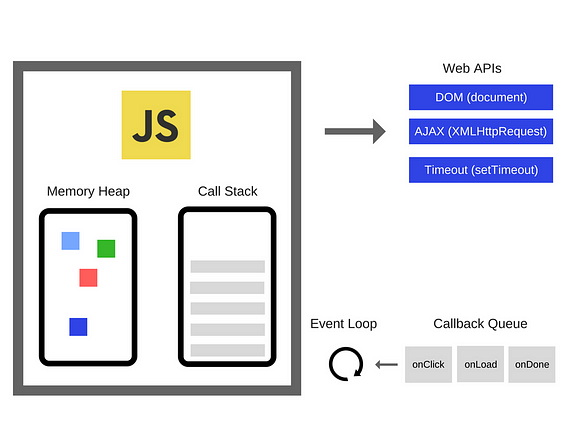What is JavaScript and how it works?
What is JavaScript?
As a language of the web, JavaScript is a powerful tool for creating interactive web pages. It is a high-level, interpreted programming language that is used to add dynamic and interactive elements to web pages. With JavaScript, website developers can add animations, user interface elements, and respond to user actions in real-time.
JavaScript is an object-oriented language that was created by Brendan Eich in 1995 while he was working at Netscape. Initially, it was called Mocha, then LiveScript, before finally being named JavaScript. It was inspired by other programming languages such as Java, Scheme, and Self.
JavaScript is a client-side programming language, which means that it runs within the user’s browser. When a user visits a web page, the browser downloads the HTML, CSS, and JavaScript files that make up that page. The browser then interprets the JavaScript code and executes it locally on the user’s computer.
In addition to being a client-side language, JavaScript can also be used on the server-side with the help of Node.js. Node.js is a runtime environment that allows developers to use JavaScript to create server-side applications. This has made JavaScript a versatile language that can be used for both front-end and back-end development.
JavaScript has become one of the most popular programming languages in the world. It is supported by all major web browsers, including Chrome, Firefox, Safari, and Internet Explorer. It is also widely used in web development frameworks such as React, Angular, and Vue.
In conclusion, JavaScript is a powerful scripting language that is used to add interactivity to web pages. It is a versatile language that can be used for both front-end and back-end development. With its wide range of uses and popularity, it is a language that every web developer should learn.
History of JavaScript
JavaScript was created in 1995 by Brendan Eich, who was working at Netscape at the time. The original purpose of JavaScript was to add interactivity to web pages and create more dynamic user experiences.
Initially, JavaScript was called Mocha, but it was later renamed to LiveScript. The name “JavaScript” was chosen by Netscape’s marketing team to capitalize on the popularity of Java, which was a popular programming language at the time.
JavaScript was first implemented in Netscape Navigator 2.0, and it quickly gained popularity among web developers due to its ease of use and versatility. In 1996, Microsoft added support for JavaScript in Internet Explorer, which further increased its popularity.
Over time, JavaScript has evolved to become a more powerful and sophisticated language. The release of ECMAScript 6 (ES6) in 2015 introduced several new features and improvements to the language, including arrow functions, template literals, and classes.
Today, JavaScript is one of the most widely used programming languages in the world. It is supported by all major web browsers and is a key component of modern web development. In addition to its use on the client-side, JavaScript is also used on the server-side with the help of Node.js, making it a versatile language that can be used for a wide range of applications.
In conclusion, JavaScript has a rich history that spans more than two decades. From its humble beginnings as a tool for adding interactivity to web pages, it has grown to become one of the most important and widely used programming languages in the world. As a web developer, it is essential to have a solid understanding of JavaScript and its many uses.
How JavaScript works
JavaScript works by manipulating the Document Object Model (DOM) of a web page. The DOM is a hierarchical representation of a web page that allows developers to interact with the different elements of a page.
When a web page is loaded, the browser creates a DOM tree that represents the structure of the page. JavaScript can then be used to manipulate this tree and modify the content and behavior of the page.
Here’s an example of how JavaScript can be used to modify the text of a web page:
// Select the HTML element with the ID "myElement"
var element = document.getElementById("myElement");
// Modify the text content of the element
element.textContent = "Hello, World!";
In this example, we use the getElementById method to select an HTML element with the ID “myElement”. We then modify the text content of the element by assigning a new value to the textContent property.
JavaScript can also be used to add interactivity to a web page. For example, we can use event listeners to respond to user actions such as clicks or mouse movements:
// Select the HTML element with the ID "myButton"
var button = document.getElementById("myButton");
// Add an event listener to the button
button.addEventListener("click", function() {
// Code to run when the button is clicked
alert("Button clicked!");
});
In this example, we use the addEventListener method to add a “click” event listener to an HTML button. When the button is clicked, the code inside the function will be executed, which displays an alert message.
In addition to manipulating the DOM and adding interactivity, JavaScript can also be used to perform more complex tasks such as making HTTP requests, manipulating data, and creating animations.
In conclusion, JavaScript is a versatile language that works by manipulating the DOM of a web page. It can be used to add interactivity, modify content, and perform a wide range of tasks. With its power and flexibility, JavaScript is a key tool for web development.
Common uses of JavaScript
JavaScript is a versatile language that is used in a variety of applications. Here are some of the most common uses of JavaScript:
1. Client-side web development
One of the most common uses of JavaScript is in client-side web development. JavaScript can be used to create dynamic and interactive web pages that respond to user actions in real-time. It is used to add animations, user interface elements, and form validation to web pages. JavaScript frameworks like React, Angular, and Vue are widely used for building modern web applications.
2. Server-side web development
JavaScript can also be used for server-side web development with the help of Node.js. Node.js is a runtime environment that allows developers to use JavaScript on the server-side. It is used to create scalable and efficient web applications that can handle a large number of requests.
3. Mobile app development
JavaScript is also used in mobile app development. It can be used with frameworks like React Native and Ionic to create cross-platform mobile applications. JavaScript allows developers to build mobile apps using a single codebase that can be deployed to multiple platforms.
4. Game development
JavaScript can also be used for game development. It is used to create browser-based games and mobile games. JavaScript game engines like Phaser and Pixi.js are widely used for creating 2D games.
5. Web-based utilities and tools
JavaScript is also used to create web-based tools and utilities. It is used to create calculators, converters, and other interactive tools that can be accessed through a web browser. JavaScript libraries like D3.js and Chart.js are widely used for creating data visualizations.
6. Browser extensions and add-ons
JavaScript can also be used to create browser extensions and add-ons. It is used to create custom functionality for web browsers like Chrome and Firefox. JavaScript is used to interact with the browser’s APIs and modify the behavior of the browser.
In conclusion, JavaScript is a versatile language that is used in a variety of applications. From client-side web development to mobile app development and game development, JavaScript is a key tool for modern web development. Its versatility and popularity make it an essential language for every web developer to learn.
Final thought
In conclusion, JavaScript is a powerful and versatile language that has become an essential tool for web development. It is used to create interactive and dynamic web pages, as well as server-side applications and mobile apps. With its wide range of uses and popularity, JavaScript has a bright future in the world of programming.
As a web developer, it is important to have a solid understanding of JavaScript and its many features. Whether you are building a simple website or a complex web application, JavaScript can help you create a more engaging and interactive user experience.
Learning JavaScript can be challenging, but there are many resources available to help you get started. Online courses, tutorials, and forums can provide you with the knowledge and support you need to become proficient in JavaScript.
As you embark on your journey to learn JavaScript, remember that practice makes perfect. Take the time to experiment with different features and techniques, and don’t be afraid to make mistakes. With persistence and dedication, you can become a skilled JavaScript developer and create amazing web applications that will delight and engage your users.














 Over 10 years of experience in managing all size of tech projects.
Over 10 years of experience in managing all size of tech projects.